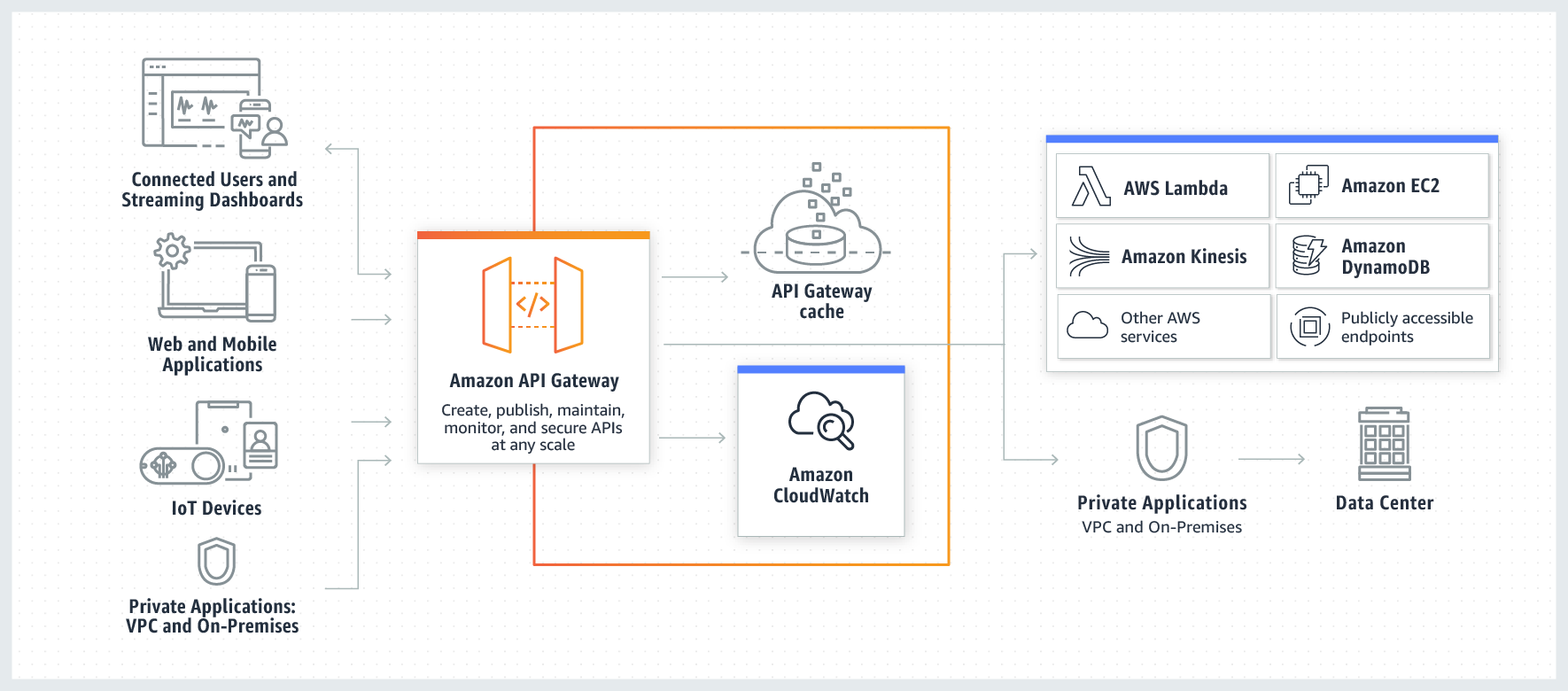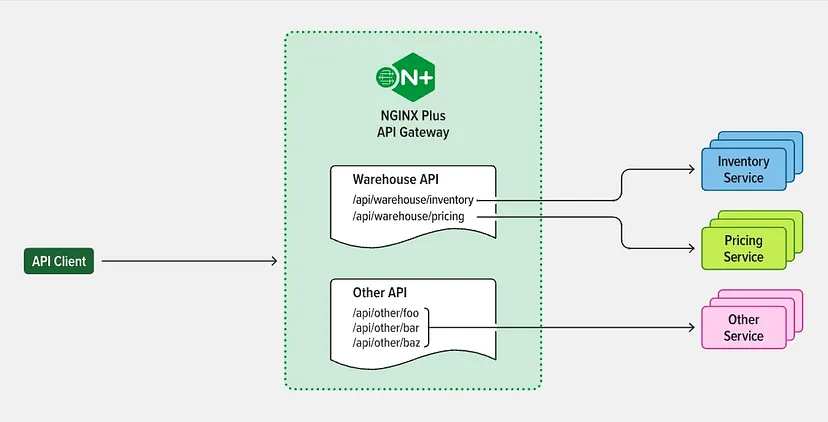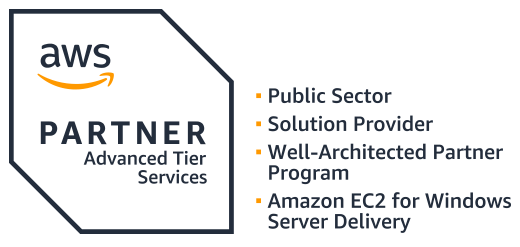Amazon API Gateway
Amazon API Gateway is a fully managed service that makes it easy for developers to create, publish, maintain, monitor, and secure APIs at any scale. APIs act as the “front door” for applications to access data, business logic, or functionality from your backend services.
Using API Gateway, you can create RESTful APIs and WebSocket APIs that enable real-time two-way communication applications. API Gateway supports containerized and serverless workloads, as well as web applications.
An API gateway is a component of the app-delivery infrastructure that sits between clients and services and provides centralized handling of API communication between them. It also delivers security, policy enforcement, monitoring, and visibility across on-premises, multi-cloud, and hybrid environments.

An API gateway accepts API requests from a client, processes them based on defined policies, directs them to the appropriate services, and combines the responses for a simplified user experience. Typically, it handles a request by invoking multiple microservices and aggregating the results. It can also translate between protocols in legacy deployments.

API gateways act as gatekeepers, ensuring data security and smooth traffic flow. Key features include:
- Security Shields: Authentication, authorization, access control, and encryption safeguard valuable data and prevent unauthorized access.
- Traffic Management: Routing, rate limiting, and manipulation ensure smooth handling of requests and responses. Circuit breakers protect against overload, while blue-green and canary deployments enable safe updates. A/B testing helps optimize experiences, and load balancing distributes traffic efficiently.
- Performance Insights: Real-time and historical metrics, logging, and tracing provide deep visibility into API health and performance.
Deploying an API gateway for app delivery can help:
- Reduce complexity and speed up app releases by encapsulating the internal application architecture and providing APIs tailored for each client type
- Streamline and simplify request processing and policy enforcement by centralizing the point of control and offloading non-functional requirements to the infrastructure layer
- Simplify troubleshooting with granular real-time and historical metrics and dashboard.
Challenges
-
Complex API Management: If you’re struggling with managing multiple APIs, with varying authentication methods, rate limits, and access controls, Amazon API Gateway can help simplify and centralize this process.
-
Security Concerns: If your existing API infrastructure lacks robust security features like authentication, authorization, and encryption, API Gateway offers built-in security controls to protect your APIs from unauthorized access and data breaches.
-
Scalability Issues: As your API usage grows, your current solution might struggle to handle increased traffic. API Gateway offers a highly scalable architecture designed to handle millions of requests per minute, ensuring smooth performance even during peak loads.
-
Integration Challenges: Integrating your APIs with different backend services and monitoring tools can be complex. API Gateway integrates seamlessly with other AWS services, making it easier to build and manage serverless applications.
-
Cost Optimization: If managing your own API gateway infrastructure is proving expensive, API Gateway’s pay-as-you-go pricing model can offer cost savings, especially for low-traffic APIs.
-
Vendor Lock-in: While vendor lock-in is a concern, AWS offers robust APIs and SDKs, allowing you to easily switch to another provider if needed. Additionally, open-source implementations of API Gateway are available, providing more flexibility.
However, it’s important to consider potential drawbacks too:
- Complexity: Adding an API Gateway layer can introduce additional complexity, especially for simple APIs. Evaluate if the benefits outweigh the added overhead.
- Performance Overhead: While optimized, API Gateway may add a slight latency increase compared to direct API calls. Benchmark and assess if this impacts your specific use case.
- Vendor Lock-in: Although less likely with AWS, evaluate different options and open-source solutions to avoid potential lock-in.
Advantages
Efficient API development
Run multiple versions of the same API simultaneously with API Gateway, allowing you to quickly iterate, test, and release new versions. You pay for calls made to your APIs and data transfer out, and there are no minimum fees or upfront commitments.
Performance at any scale
Provide end users with the lowest possible latency for API requests and responses by taking advantage of our global network of edge locations using Amazon CloudFront. Throttle traffic and authorize API calls to ensure that backend operations withstand traffic spikes and backend systems are not unnecessarily called.
Cost savings at scale
API Gateway provides a tiered pricing model for API requests. With an API Requests price as low as $0.90 per million requests at the highest tier, you can decrease your costs as your API usage increases per region across your AWS accounts.
Flexible security controls
Authorize access to your APIs with AWS Identity & Access Management (IAM) & Amazon Cognito. If you use OAuth tokens, API Gateway offers native OIDC and OAuth2 support. To support custom authorization requirements, you can execute a Lambda authorizer from AWS Lambda.
RESTful API options
Create RESTful APIs using HTTP APIs or REST APIs. HTTP APIs are the best way to build APIs for a majority of use cases—they’re up to 71% cheaper than REST APIs. If your use case requires API proxy functionality and management features in a single solution, you can use REST APIs.
Case Study
OCSS (One Cloud Storage Solution) emerges as a beacon of efficiency, offering a comprehensive solution for organizing, conducting, and recording virtual meetings.
However, the proliferation of various meeting platforms has led to fragmentation, hindering efficient communication and information exchange.
Challenges:
- Tool Overload: Multiple online meeting tools cause confusion and lack of cohesion, hindering effective communication and decision-making.
- Fragmented Collaboration: Incompatibility between meeting platforms leads to disjointed workflows and increased errors in managing meetings.
- Information Management Challenges: Manual processes for storing and recording meetings result in inefficiencies and the risk of losing important data, hampering productivity.
- Security and Compliance Risks: Lack of standardized meeting management heightens the risk of data breaches and non-compliance with regulations, posing a threat to organizational reputation and trustworthiness.
Solution:
- Centralized Platform: OCSS offers a centralized platform for managing, recording, and storing meetings, addressing the challenges of scattered discussions and decisions.
- API Gateway Integration: Powered by API Gateway integration, OCSS acts as a cohesive agent, bridging the gap between disparate meeting platforms.
- Automated Recording Management: API Gateway enables automated recording initiation and management, reducing user workload and ensuring consistency in meeting records.
- Enhanced Security and Compliance: OCSS implements robust encryption and access controls to safeguard confidential information and ensure regulatory compliance.
- Interoperability: API Gateway facilitates smooth communication between OCSS and various meeting platforms, enhancing interoperability and maximizing investment in meeting technology.
- Foster Cooperation and Productivity: By embracing OCSS, organizations can unlock the full potential of virtual collaboration, fostering cooperation, enhancing productivity, and mitigating security and compliance concerns.
Result:
-
Unified Platform: OCSS offers a unified platform for virtual meetings, simplifying scheduling and management across multiple platforms.
-
Increased Productivity: Users experience enhanced productivity and efficiency due to streamlined meeting processes and a user-friendly interface.
-
Improved Collaboration: Organizations benefit from improved collaboration and decision-making, with critical insights recorded and preserved for future reference.
-
Enhanced Security and Compliance: OCSS’s API Gateway integration strengthens data security and compliance by enforcing uniform protocols and guidelines across connected platforms.
-
Empowerment for Innovation: OCSS with API Gateway integration empowers businesses to leverage remote collaboration fully, driving success and innovation in today’s digitally driven world.
Get Started with Genese
Genese Expertise:
- Deep API knowledge: Our team of experts guides you through every step of the process.
- Security best practices: We ensure your APIs are protected against evolving threats.
- Performance optimization: We fine-tune your API Gateway for maximum speed and efficiency.
- Integration specialists: We seamlessly connect your APIs with your existing infrastructure.
Ready to unlock the API Gateway potential?
- Free API Gateway Assessment: Analyze your current setup and identify optimization opportunities.
- API Gateway Proof of Concept: Experience the power firsthand with a tailored demo and trial.
By integrating the robust capabilities of API Gateway with Genese’s proficiency, you can convert your data into a well-defined and actionable pathway for success. Dive in and harness the power of API Gateway to make waves today!
Pick Genese as an Advanced Tier Services Partner for your AWS needs

Looking for AWS Services?
 Finland
Finland Bangladesh
Bangladesh